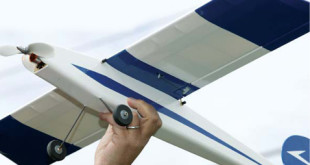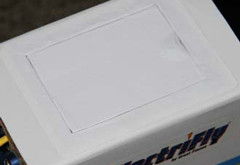If you have ever tried to set up solid aileron pushrods with Z-bend linkages, you know the frustration of trying to get the second bend in just the right place, or adjusting a V-bend in the middle of your pushrod. It turns out that there is an easier way. Here is how I bend aileron pushrods for most models with wing-mounted aileron servos. In this case, I was setting up the new Small Stik from Aero Craft Ltd. The same technique can be used on models up to 60 size and beyond, depending on the pushrod wire size.
Read More »How To’s
Making Hatches
I've been a sport modeler for 30 years. Along the way, I have discovered some simple techniques for making hatches. Here are a few that I've relied on. Given the expansion of onboard widgets of all kinds, you just may find yourself wanting some hatches to better access electrical connections and components on any brand of ARF. First, let's look at how the designers at Goldberg and Great Planes paved the way, and then we'll look at a very simple magnetic hatch you can build in 20 minutes.
Read More »Glow Engine Maintenance
This month I will discuss how I overhaul a basic two-stroke glow engine. I will be disassembling an O.S. .46 SF, cleaning the various parts, doing an inspection and replacing the bearings before reassembling and test running the engine. The techniques shown are applicable to any brand of engine.
Read More »Anderson Powerpole Installation Secrets
Anderson Powerpoles are among the safest, most reliable and most useful of all connectors for electric- powered airplanes. They are easy to disconnect (you won’t damage your plane pulling them apart), expose no live metal contacts and do not require soldering. Here, we will discuss additional key installation tips and tricks that, until now, have been known only to the “experts.â€
Read More »Finishing Foam
Once upon a time, in a land across the sea, there lived a little foam ice chest. Deep in its heart, the ice chest dreamed of flying like the birds. Lo and behold the wizard of ARFs visited the ice chest’s village. The foam ice chest begged the wizard to let it fly. With a whoosh, a boom and a blinding flash of light, the ice chest was transformed into an electric 40-inch Tiger Moth model airplane that did indeed fly with the birds. However, the Tiger Moth’s skin still looked like the skin of an ice chest. It was soft, easily damaged and not very pretty. It could fly, but it was definitely an ugly duckling. Enter Tony Albence, an artist from the land of Delaware, here in the US of A. Tony has been using a process with only common modeling supplies that transforms such foam models. Here is how he helped the pitted, ugly duckling become a durable, smooth-surfaced swan.
Read More »Build A Connector For The Astro Blinky Balancer
Just a few years ago, LiPo cells and packs without balancing connectors were available. If you own any of these early birds and want to bring them into long-term service by adding a balancing connector, this article is for you. Although most of today's packs typically have balancing connectors (admittedly, with different form factors), a number of companies still offer individual cells without such connectors.
Read More »RC On The Road
Why not fly radio control planes when you are away for work? If you enjoy model planes and occasionally have to travel for work, keep reading.
Read More »First Timer’s Crash Repair
RTF planes are great for introducing new folks to the hobby, but as a former hobby shop employee, I’ve heard several folks comment on how if they somehow crashed a plane like Hangar 9’s P.T.S. P-51 Mustang, they’d have to throw it away and get a new plane. In hopes of combating the thought that an easy-flying plane like the Hangar 9 P.T.S. Mustang would be destined for the trash bin after a crash, I decided to show the rebuild ofmy own crashed Mustang from a first-timer’s perspective.
Read More »Hold A Club Pylon Race
Many people often think of one word when they talk about racing: expensive. It’s a common misconception that one should overcome, because when you think of racing, it should be FUN!
Read More »Cutting Gaskets
To run properly, 2-stroke engines rely on perfect sealing in critical areas. In an ideal world, gaskets would not be needed. With two perfectly machined mating surfaces—much like the old Dick McCoy engines of the ’50s—a gasket isn’t even necessary. But most manufacturers use gaskets to guarantee a leak-free, airtight seal.
Read More »Soldering Wire Landing Gear
Spring steel wire, also known as music wire, is one of the most popular model landing-gear materials. It is readily available at most hobby shops, inexpensive, strong and easy to form into just about any shape imaginable with common tools. Whether you are scratch-building a new design, building a kit, or just repairing the gear for your latest ARF, no modeler’s skill set is complete without a few basic techniques for working with music wire.
Read More »Glow Engine Tuning & Setup
This is the first installment of a series of articles on general engine care and maintenance of both glow and gasoline engines. I will cover most of the basics, including setting up your engines, basic cleaning, maintenance and troubleshooting. This month I will discuss the basic setup and tuning of two-stroke glow engines (without a fuel pump), still by far the most commonly used engines in our models.
Read More »Optimize Your Fuel System For Best Performance
The fuel system is one of the most important parts of your airplane, but how much do you really know about it?
Read More » Fly RC Magazine WE LIVE RC
Fly RC Magazine WE LIVE RC


